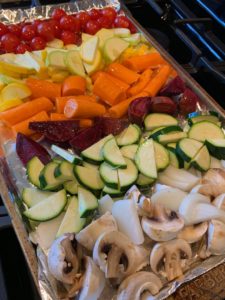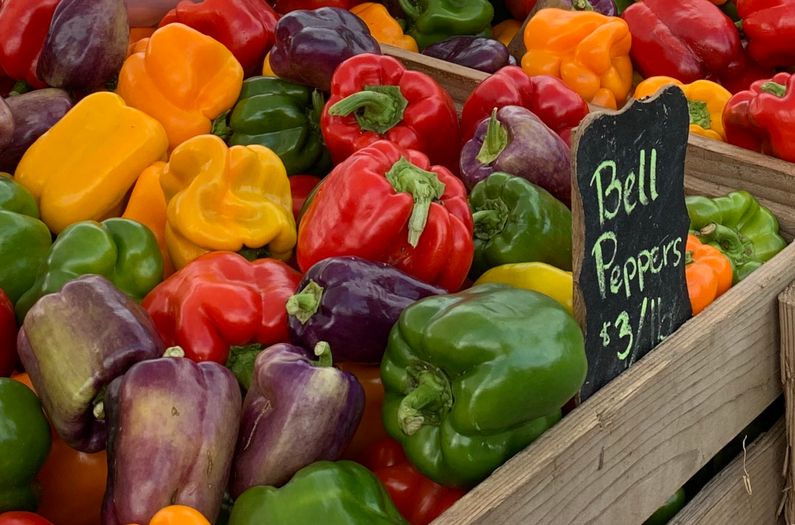Do you find it hard to eat your veggies? If so, you are not alone. Many people find it difficult to get even just 1 or 2 servings of vegetables in per day. We tend to plan our meals around meat, potatoes and pasta but little thought goes into the rainbow of colorful vegetables that are available to us and should make up the bulk of our meals.
Do we really need to eat more vegetables? The answer is yes! Vegetables are an important part of a healthy diet for several reasons.
- They contain essential fiber necessary for healthy gut flora and intestinal health. This fiber passes through the intestines cleaning the intestinal walls and removing particles of partially digested food and waste along the way. If these particles are left behind, they can cause serious infections and disease.
- Vegetables are loaded with micronutrients in the form of vitamins and minerals. These powerhouse nutrients support every function of the body including bone and muscle development, thyroid health, brain and heart function, liver health, hormone regulation and much more. Eating from a larger variety of vegetables that are in season, is the best way to get all the nutrients needed to support the bodies requirements.
- Vegetables provide variety and substance to your plate with very few calories, meaning you can eat more food without consuming a lot of excess calories.
How do we include more vegetables in our daily diet? Here are 5 simple tips that will provide an abundance of nutrient rich vegetables that are loaded with vitamins, minerals and fiber.
Set a Goal
When planning lunch and dinner, make sure to include a minimum of:
- 1 cup of veggies, either raw or cooked or
- 2 cups of leafy greens
Sauté vegetables with healthy fats such as olive oil, coconut oil or butter. Drizzle steamed vegetables with melted butter or olive oil and season with salt, pepper, garlic powder or other seasonings of choice. For salads, choose a homemade vinaigrette or other salad dressing made with olive oil or avocado oil. Avoid dressings with added sugar and processed oils. Adding fat to your vegetables will help the body to absorb fat-soluble nutrients such as vitamins A, D, E & K and it also adds flavor to the dish. Feel free to eat as much and as many of these veggies as desired but set your goal to eat at least the minimum two meals per day.
Plan Ahead
Have plenty of healthy options on hand. Most people find that planning their meals, on a weekly basis or at least for a few days at a time, works best. Determine what meals or foods you want to prepare. Take inventory of your kitchen to see what groceries need to be purchased and build your shopping list. Shop and make sure you have everything you need on hand.
If you are short on time during the week, prep some of your foods ahead of time on your day off.
- Make a veggie frittata that can be portioned out over a few days or a big pot of soup that is loaded with vegetables.
- Slice sticks of carrots, celery, bell pepper, jicama and zucchini that are fun to dip for snacks and can be added to your lunch box.
- Wash all lettuces and greens, spin dry and store refrigerated so they are ready for use over the next several days.
- Roast a tray of vegetables for the week that you can easily add to salads, reheat as a side dish or combine with chicken broth and puree into a soup.
- If you know you will need chopped onion for a meal on Monday, and then again on Wednesday, chop enough for both dishes and store the Wednesday portion in a sealed container until ready to use.

Roast veggies ahead of time to have on hand for quick meals.
Build Your Meal Around Veggies
While adding salad or vegetable as a side dish are all good options, consider building your meals around the vegetables. For example, substitute thinly sliced zucchini and eggplant for lasagna noodles. Use cauliflower rice instead of traditional rice in your main meals. Try Butternut Squash Crinkle Fries dipped in Sriracha sauce instead of French Fries. Also, look for main dish recipes that include plenty of vegetables in the ingredients such as Spaghetti Squash Bolognese or Paleo Shepherd’s Pie.
Eat the Rainbow to Find Your Nutritional Pot of Gold
Did you know that, while there are literally hundreds of vegetable varieties to choose from, Americans on average eat less than 10 of them?
Try to eat the colors of the rainbow including red, orange, yellow, green, blue and purple to insure you are getting the maximum nutrition. Focus on dark, leafy greens and a variety of brightly colored produce including lettuces, arugula, chard, kale, cauliflower, broccoli, green beans, zucchini, eggplant, bell peppers, onion and mushrooms. Add in some squash and root vegetables such as pumpkin, acorn squash, butternut squash, yams, sweet potatoes, potatoes, carrots, beets, rutabagas and cassava. These are all ideal sources of soluble and insoluble fiber and are rich in vitamins and minerals.
Fiber in starchy vegetables help bulk up a meal making it more filling but they don’t just feed the human body! These foods are a terrific source of insoluble fiber or prebiotics. Insoluble fiber does not break down in the small intestine. Instead it passes through to the large intestine becoming food for the healthy bacteria that live in the gut. For more on the benefits of prebiotics and probiotics, see 6 Steps to Improve Your Gut Health.
Start Your Day Off Right!
BONUS if you include vegetables in your breakfast, in addition to lunch and dinner!
Enjoy a refreshing Green Keto Smoothie that is satisfying for hours or an Italian Sausage Garden Skillet for a breakfast that’s a little more hardy. Even a bowl of cottage cheese with diced tomato and drizzled with flax oil or olive oil makes a quick healthy breakfast or snack, although tomatoes are technically fruit J
Remember, for the best tasting and nutrient dense vegetables, choose fresh produce that is in season. Opt for local grown and organic if possible but if your choices are limited, do the best you can. Each week when shopping, I like to choose several vegetables that I know my family likes and then select one or two new veggies that we haven’t tried before. I will Google or search Pinterest for recipes to learn how to prepare them. Not all veggies we’ve tried are keepers (I am not a fan of Brussel sprouts) but we keep an open mind. And we are often happily surprised!





To the simply28.com admin, You always provide clear explanations and definitions.
Im thankful for the blog post. Awesome.
Dear simply28.com administrator, Thanks for the well-researched and well-written post!
Hello simply28.com administrator, You always provide in-depth analysis and understanding.
Hi simply28.com owner, Thanks for the well-organized and comprehensive post!
Hi simply28.com owner, Thanks for the well-researched post!
To the simply28.com webmaster, Excellent work!
Hi simply28.com administrator, Keep up the great work!
Dear simply28.com webmaster, Keep sharing your knowledge!
Hello simply28.com owner, You always provide valuable information.
priligy sg Diagnostic performance of computed tomography angiography for differentiating ischemic vs nonischemic cardiomyopathy
Thanks for your marvelous posting! I genuinely
enjoyed reading it, you might be a great author.
I will always bookmark your blog and will eventually come
back down the road. I want to encourage you to continue your great writing, have a nice evening!
Also visit my web blog … Nordvpn Coupons Inspiresensation – Tinyurl.Com –
Thanks for finally talking about > 5 Simple Tips to Make Eating your Vegetables Painless – Simply28 Nutrition nordvpn coupons inspiresensation
Hey there! I know this is sort of off-topic however I needed to ask.
Does operating a well-established website such as yours take
a massive amount work? I’m completely new to operating a blog however I do write in my diary daily.
I’d like to start a blog so I can easily share my personal experience and feelings online.
Please let me know if you have any kind of suggestions or tips for brand new aspiring bloggers.
Thankyou!
Feel free to surf to my web-site; nordvpn coupons inspiresensation (s.bea.sh)
350fairfax nordvpn discount
Heya i’m for the first time here. I came across this board and
I in finding It truly helpful & it helped me out much. I am
hoping to offer something back and aid others like you aided me.